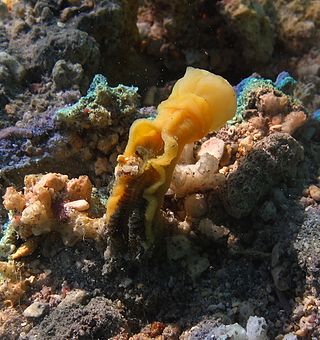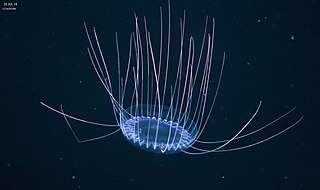
Johannes Japetus Smith Steenstrup FRS(For) HFRSE was a Danish zoologist, biologist, and professor.
Desmopteridae is a family of pelagic sea snails or "sea butterflies", marine gastropod mollusks in the superfamily Cymbulioidea.

Carl Gegenbaur was a German anatomist and professor who demonstrated that the field of comparative anatomy offers important evidence supporting of the theory of evolution. As a professor of anatomy at the University of Jena (1855–1873) and at the University of Heidelberg (1873–1903), Carl Gegenbaur was a strong supporter of Charles Darwin's theory of organic evolution, having taught and worked, beginning in 1858, with Ernst Haeckel, eight years his junior.

Morphology is a branch of biology dealing with the study of the form and structure of organisms and their specific structural features.

Balanoglossus is a genus of ocean-dwelling acorn worms (Enteropneusta). It has zoological importance because, being hemichordates, they are an "evolutionary link" between invertebrates and vertebrates. Balanoglossus is a deuterostome, and resembles the sea squirts (Ascidiacea) in that it possesses branchial openings, or "gill slits". It has a notochord in the upper part of the body and has no nerve chord. It does have a stomochord, however, which is a gut chord within the collar. Their heads may be as small as per 2.5 mm (1/10 in) or as large as 5 mm (1/5 in).

Rhizostomeae is an order of jellyfish. Species of this order have neither tentacles nor other structures at the bell's edges. Instead, they have eight highly branched oral arms, along which there are suctorial minimouth orifices. These oral arms become fused as they approach the central part of the jellyfish. The mouth of the animal is also subdivided into minute pores that are linked to coelenteron.

The Pelagiidae are a family of jellyfish. Members of the family Pelagiidae have no ring canal, and the marginal tentacles arise from umbrella margin.
Emil Rosenberg (1842–1925) was a biologist and professor of comparative anatomy, embryology and histology, who worked 20 years at the Imperial University of Dorpat.

Solmissus, or dinner plate jellyfish, is a genus of hydrozoans. Its species are unique among cnidarians in that they actively hunt for prey as opposed to passively waiting for plankton to pass by. They are found in the deep waters of Monterey Bay, California. They are most likely to be found in the deep sea, mid water. They grow to be 20 cm (7.9 in) in diameter. These hydrozoans feed on gelatinous zooplankton, including salps and doliolids, ctenophores, jellyfish, and copepods. However, Solmissus may be limited to feeding on soft-bodied prey by the type of nematocysts on their tentacles (Mills).

Julius Victor Carus was a German zoologist, comparative anatomist and entomologist.

Jacques Vladimir von Bedriaga was a herpetologist from the Russian Empire who was a native of Kriniz, a village near Voronezh.

Rhopalonematidae is a family of hydrozoans. The family comprises 15 genera and 36 species.
Eurhamphaeidae is a family of ctenophores.

Cuninidae is a family of hydrozoans in the order Narcomedusae. They have dome-shaped bells and tentacles set above the undulating margin of the bell. Their gastric pouches contain the gonads situated in line with the tentacles, the number of pouches being the same as the number of tentacles. The pouches do not extend below the points of origin of the primary tentacles. Members of some genera have a peripheral canal system and others do not. No radial canals or secondary tentacles are present.
Solmarisidae is a family of hydrozoans in the order Narcomedusae. The name is sometimes spelled "Solmaridae".

The Diphyidae are a family of siphonophores. These are colonial siphonophores with two nectophores arranged one behind the other. The front one includes a somatocyst, while the hind one does not. The somatocyst often contains an oil droplet for buoyancy control. A nectosac in each nectophore allows the organism to swim efficiently.

Capitata is a suborder of Hydrozoa, a class of marine invertebrates belonging to the phylum Cnidaria.

Sminthea is a genus of deep-sea hydrozoans of the family of Rhopalonematidae,

Rhizophysa is a genus of cnidarians belonging to the family Rhizophysidae.

Zanclea is a genus of hydrozoans belonging to the family Zancleidae.















